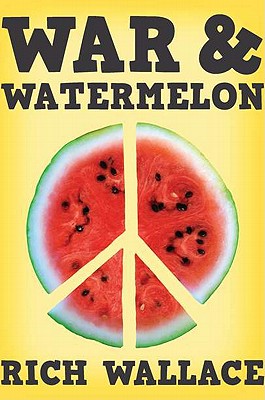
What is it about being a white, middle (or upper-middle) class kid that means you have to doodle peace signs on everything? My daughter is 7 and has already learned how to make these little symbols and adds them to many of her drawings. My 5-year-old son has even started making them, all lopsided though they may be. I certainly did it; I have the class notes to prove it (Yep. I've kept my notes. That's just how nerdy I am.) Casting our minds back to the 60s and 70s - BEFORE WE WERE EVEN BORN - seems like just part of growing up, like seeking independence in your life means you have to look to those godfathers of rebellion: the hippies. But for all the ridiculous romanticizing of what was honestly not that great a time period, what with segregation, Vietnam, and all the great leaders getting shot, it was still an important period in history and is worthy of writing about.
In War & Watermelon, Rich Wallace has done a little bit of the romanticizing part and a little bit of the capturing history part. He tells the story of 13-year-old Brody in the fabled summer of '69. Brody plays football, hangs out with his buddy Tony, listens to the radio, and worries about his brother, Ryan, who will be 18 soon and will likely be drafted and sent to Vietnam.
This book was recommended (and gifted) to me by Serena at Savvy Verse & Wit (see her review here) as a great book for that hard-to-recommend-for 10-12 year old boy set. It does a good job of capturing the kind of real-life angst, not melodrama, that middle school boys might honestly experience. The sports play-by-plays were especially good, I thought, because even my grown husband still feels compelled to provide me with way more detail to my simple question: "How did the game go?" Recounting plays resonates with a lot of guys, so this relatively insignificant part of the plot goes a long way toward establishing credibility to those young readers.
Too much of the rest of it seems like it might lose the interest of the average teenage boy or even his mother, especially the Top 40 song references and the poems that were scattered in between chapters randomly. As coincidence would have it, I was sick yesterday and watched the first episode of The Wonder Years on Netflix. Same time period, same situations for the characters: Kevin and Paul are starting Junior High; Winnie's older brother gets drafted. They don't make it to Woodstock, but the similarities are otherwise striking. Equally striking, however, is how much more emotional punch a single 24-minute episode of The Wonder Years can pack as opposed to this novel.
The thing is, this book might be fantastic to a boy reader and it might not. It's not terribly edgy; in fact, it plays most things downright safe. There's not a whole lot of action, at least not the kind many middle-school boys are accustomed to in tv and movies. It seems simultaneously too young (all the playing it safe) and too old for them (It is Woodstock, after all. Nudity and pot smoking required). Since I am not a teen boy and haven't worked with them in awhile, I just don't know how to gauge their likely response. So, I'm going to gift my signed copy to the Middle School library at the all-boys school where my husband works, and I'm going to ask the librarian to give me some feedback on whether or not guys actually like it.
As for what boys this age do like (and girls and all the other ages), The Center for Teaching and Learning keeps a regularly updated list of books recommended by kids on their website. The kids there (under the expert leadership of one of my heroes, Nancie Atwell) take reading pretty seriously, so you can trust that the stuff on the list has been genuinely enjoyed.

I'm not sure how boys would like it either...I don't have any young boys or know any, but if they want edgier, they should read the war novels of Walter Dean Myers
ReplyDeletebtw, I added your review link at War Through the Generations under the Vietnam War reviews.
ReplyDelete